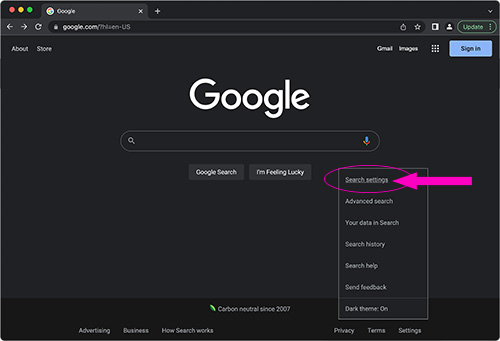


Article by Newsletter Editorial Board
Posted March 2022There are always new tricks to learn in computing. This time around, here are some search tips that you can use with Google (and most any other search engine) and may not be aware of, with thanks to the Internet and PC Mag.
First trick: refine your searches with operators. A product so ubiquitous that it spawned its own verb, according to PC Magazine, Google accounts for 86% of the world’s web searches. That means Google serves several billion searches a day.
Google can tell you the weather, translate languages, define words, give you directions, and much more. When was the last time you argued with friends over something and didn’t check Google for the answer?
Even if you use Google multiple times a day, there’s probably a lot you don’t know about the search engine. If you’ve ever struggled to get the results you want, or just want to know a few inside tricks, the tips below will improve your Googling skills.
Google’s search algorithm is very adept at returning the information you are looking for. But for those times when you aren’t getting what you would like, you can refine your search results with operators.
Use quotations (“ “) to search for the exact phrase: If you search for Bob Dylan young, you will get results that have all those words, but not necessarily in the order you search. By adding quotations and searching “Bob Dylan young,” you will get only results that include all those words in that order.
Add a tilde (~) in front of a word to find synonyms: Use this to search for a specific word and any synonyms for that word. If you search for iPhone ~cheap, you will also get results for “iPhone inexpensive,” and so forth.
Exclude terms with a minus (-) symbol: Use the minus symbol to exclude all the terms you don’t want, e.g. best apps -android for results that omit roundups of top Android apps.
Insert two periods (..) between numbers to search for a range: If you want to narrow results to a date or price range, use two periods in between the numbers. You could be looking for a computer within a certain price range, so you could search computer $500…$900 to only get results that fit into that range.
Find one result or the other with OR: If you’re looking for results that are about one topic or another, but nothing else, use the OR modifier to get more accurate results. For example, searching apple Microsoft will surface results relating to either term, but searching “apple OR Microsoft” provides you with separate links about Apple and Microsoft.
Add site: to search a single website: If you want results from one specific website, use site: followed directly by the site URL you wish to use. You must include the site’s domain.
Search File Types: If you’re looking for a specific kind of file on the internet, use filetype: to search only for uploaded files that match your query. For example, use filetype:pdf to find a PDF or filetype:doc to locate a Microsoft Office document. You can find a comprehensive list of searchable file types here.
Search Related Websites: Search for similar websites by using the related: qualifier to show related results. Searching related:amazon.com brings up results including Walmart and Overstock. Searching related:google.com shows Yahoo and Bing.
Don’t want to learn all these modifiers? You can use them in an advanced Google search. From the Google results page, click the gear icon and choose Advanced search to open a new advanced search page. This allows you to enter keywords or phrases in specific fields instead of relying on specific modifiers. Results can be narrowed even further by language, region, last update, domain, term location, explicit content, file type, and usage right. Image searches can also be narrowed by image size, aspect ratio, color, and image type.
While you can’t create an advanced search on mobile, you can filter your image search. Tap the slider icon at the top of your image search to filter by most recent, GIF, HD images, images of products, color, and usage rights.
Setting time constraints can be helpful. Looking for only the latest news about a subject or trying to find information relevant to a specific period? Use Google’s search tools on desktop and mobile to filter your search results. When on desktop, click Tools under the magnifying glass icon. On mobile, swipe to the end of the list of Google search types and select Search tools.
Select Any time to open a drop-down menu that can help you narrow results to the past hour, 24 hours, week, month, and year. Desktop users can select Custom range to enter specific dates.
Google supports “backward” image searches on most browsers. This function allows you to upload an image file and find information on that image. For example, if you uploaded a picture of the Eiffel Tower, Google will recognize it and give you information on the Paris monument. It also works with faces and can direct you to websites where the image appears, identify a work of art, or show you images that are “visually similar.”
Go to Google Images and just drag and drop an image into the search bar. You can also click the camera icon to upload an image or enter an image’s URL. (Here’s how to do a reverse image search on your phone.)
Google now has a dark mode option that can turn your search results black. From a search results page on the desktop, click the Settings gear on the top right and select Dark Theme under Appearance. (On google.com, you can also click Settings on the bottom right and select Search Settings > Appearance > Dark theme.) You can also select Device default so it matches your other theme settings.
On mobile, select the hamburger menu in the top-left corner of Google’s search results and choose Dark theme to toggle it on and off.

There’s lots more, but this is a good stopping point. To be continued…
Questions or comments? Drop me an email: jwh3@mindspring.com